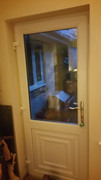Joeboy wrote: ↑Tue Oct 26, 2021 6:54 pm
Pilkington K glass and as with all double glazing there is 'some' cold transmission. The 'blinds' will make a difference. Had a trial last year on the side door and it worked quite well.
Not sure I'd choose bad as a description but would go with 'can be improved'!

Plus we are enjoying all our wee projects together. SWMBO came thru yesterday with a massive sheet of brown paper and a big 'well chuffed with herself' smile. We will use it to cut a template.
I think you know about my product which essentially turns single glazed windows into (basic) double glazed windows. It relies on reasonably thick square frames for installation, and therefore my main customer segments are people with period properties and sash windows etc.
But I'm working on a version which could be attached to (almost) any window, even those without a protruding frame (such as yours). Idea is that my panel would attach directly to the glass. In principle, that's attractive, as all windows have a nice flat dependable glass surface to which to attach. The problem is finding a way to do it which also allows for easy removal of my panel, as I'm just not comfortable with a product you can't remove easily (if misting occurred, it would be a pain to sort). I'm looking at an approach similar to the common magnetic tape approach.
Anyway, point is there's actually a lot more old, poorly performing double glazing about than there is single glazing. Hence I'm interested in providing a way to improve that rather than replace it (as replacing it is expensive and has an appalling return on embedded carbon), by turning it into triple glazing. Sure it wouldn't come anywhere near 'proper' triple glazing in terms of performance, but it could be a quick and affordable way to bump up the thermal performance (up to 30% reduction in the -pane- U value I think just by adding an extra cavity of about 11mm depth).
I might come back here looking for willing volunteers to trial them before long!



